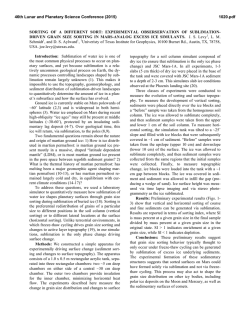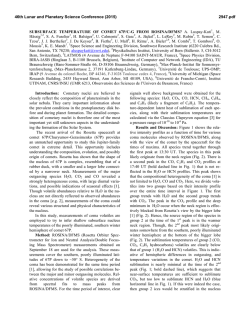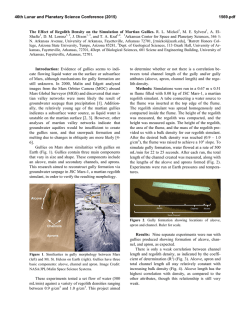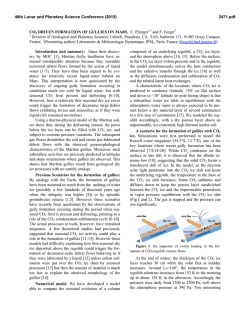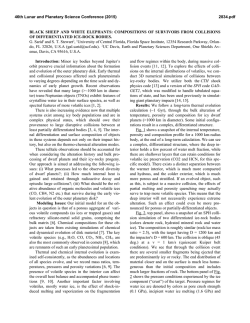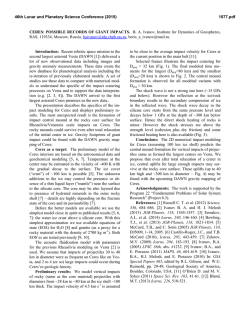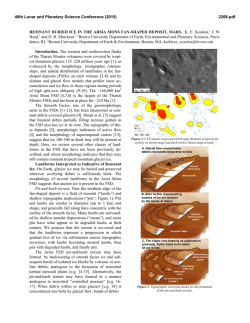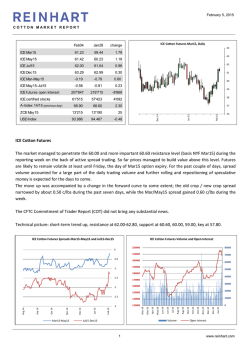
Modeling of Sublimation-Driven Erosion and Ice Pinnacle Formation
46th Lunar and Planetary Science Conference (2015) 1589.pdf MODELING OF SUBLIMATION-DRIVEN EROSION AND ICE PINNACLE FORMATION ON CALLISTO. O. L. White1, O. M. Umurhan1, A. D. Howard2, and J. M. Moore1. 1NASA Ames Research Center, MS 245-3, Moffett Field, CA 94035-1000 ([email protected]), 2University of Virginia, Department of Environmental Sciences, P.O. Box 400123, Charlottesville, VA 22904-4123. Introduction: Most of the areas observed at high resolution on the Galilean satellite Callisto have a morphology that implies sublimation-driven landform modification and mass wasting is at work [1]. These areas comprise rolling dark plains with interspersed bright pinnacles. Using the MARSSIM landform evolution model, evolution of this landscape has been simulated heuristically as a combination of bedrock volatile sublimation, mass wasting of the dark, non-coherent residue, and redeposition of ice at high-elevation cold traps sheltered from thermal re-radiation to form the pinnacles [2]. The goal of our study is to advance the physical treatment of these processes within the framework of the existing MARSSIM model, and to quantitatively relate our model results to the actual surface of Callisto through visual and topographic characterization of surface features. Simulations performed using this refined version of the model will ultimately allow us to form a coherent narrative of the evolution of Callisto’s surface that illustrates the influence of factors such as ice composition and total radiation input on the relative rates of pinnacle formation and sublimation weathering. A New Physics-Based Model for MARSSIM: The MARSSIM landform evolution model has been developed to quantitatively evaluate a wide range of processes modifying planetary surfaces, and includes a variety of statistical routines to characterize landform morphology [3]. Adapted for the purpose of modeling ice sublimation and deposition on Callisto, mass wasting modules from earlier terrestrial and Martian investigations were retained, but new routines to simulate exposure-influenced bedrock weathering and frost deposition were included [2]. We have incorporated a number of refinements into a new version of the model that more strictly adheres to the physical processes interpreted to be operating on Callisto, which we describe below. The earlier form of MARSSIM modeled sublimation weathering of the ‘bedrock’ (i.e. crustal material comprising fine-grained refractory material that is cemented by ice, and which is not subject to creep) via surface decrescence and depending on exposure to thermal re-radiation in eight directions from the surrounding landscape [2]. We have modified the exposure criteria such that the effect of direct solar illumination is considered in addition to thermal re-radiation. The illumination angle is set according to the latitude the scene exists at; it is assumed that midday illumination always prevails (Fig. 1). Fig. 1. Illustration of the current model for radiation input to a certain point on Callisto’s landscape. We use these exposure criteria, in combination with the surface albedo, to determine a surface temperature at each point [4] that is used to calculate volatile escape rates of ice in exposed bedrock and in bedrock covered by a regolith layer. If bedrock is exposed, we calculate an escape rate based on the vapor pressure of the relevant ice and the surface temperature [5]. Our model also allows for sublimation weathering of pinnacle ice itself. If the bedrock is covered with regolith, then we define a temperature profile through the regolith based on values for the thermal inertia of the regolith layer and the bedrock underneath [6] in order to determine the diurnal temperature variation at the regolith/bedrock interface where sublimation will occur. We input the mean interface temperature into Fick’s Law in order to calculate the rate of passage of sublimated volatiles through the regolith layer, and its escape rate at the surface [7]. Current results. Fig. 2 presents the results of our current simulations, assuming H2O ice composition for the volatile component of the bedrock. The figures illustrate the correlation of low surface temperatures to low exposure localities, which act as sites of pinnacle growth. Over a billion year timescale, we see development of pinnacle ice thicknesses reaching up to 90 m, a figure that is consistent with measurements of total pinnacle relief [8]. 46th Lunar and Planetary Science Conference (2015) Fig. 2. (a) Shaded relief map of initial, crater-saturated simulation surface, measuring 12.8 km by 12.8 km. (b) Initial map of surface temperature resulting from exposure to thermal re-radiation (0° solar incidence angle). (c) Ice thickness map at end of simulation (1 Gyr elapsed time). Effect of ice composition: The composition of the ice that is sublimated and re-deposited to form the pinnacles will be strongly influential on the rate at which sublimation progress, and therefore on the amount available to form pinnacles. By analogy, it will also affect the rate of regolith growth in areas of net sublimation. The sublimation rate of a particular ice species is most influenced by its vapor pressure relationship with temperature (e.g. [6, 8, 9]). For CO2 and H2O ice, which have both been detected at Callisto’s surface [10], the CO2 ice vapor pressure is many orders of magnitude greater than that for H2O ice at Callistoan surface conditions. The sublimation rate of CO2 from the bedrock is therefore orders of magnitude higher than that for H2O, and its behavior is too volatile to 1589.pdf allow it to redeposit in cold traps after it sublimates. Sublimation of CO2 ice is therefore the likely source of the majority of the regolith covering the low-lying parts of Callisto’s landscape – at Callisto’s equator, our simulations indicate build-up of several meters of regolith cover over a 4 Gyr timescale due to CO2 sublimation. Indeed, an analytical calculation shows that CO2 sublimation-driven surface regolith production on a flat surface at the equator will have a regolith depth as a function of time given by L ~ 3 t meters with a corresponding surface outgassing rate of 2.7´10 7 1/ t mols cm-2 s-1 (t in units of billions of years). The corresponding present-day sublimation rate through such a regolith cover is comparable (within a factor of two) to that which is needed to replenish Callisto’s tenuous CO2 atmosphere [11]. We find that sublimation of H2O ice can occur at a sufficient rate to produce pinnacle ice thicknesses that are consistent with observations (Fig. 2); however, the vapor pressure of H2O ice is low enough such that only a few centimeters of regolith will reduce the escape rate of sublimated H2O to a negligible value. Instead, the majority of the deposited ice is sourced from thin margins of exposed bedrock that remain on crater walls that are steep enough such that any regolith produced by sublimation is mass-wasted away. Conclusion: The rapid growth of regolith cover caused by CO2 sublimation implies that this cover was already well-developed by early on in Callisto’s history, leaving a negligible amount of exposed bedrock available for sublimation of H2O. Instead, pinnacle formation would have been a more protracted process stemming from the sublimation of H2O ice that remained in the regolith left behind after CO2 sublimation, rather than H2O ice in the bedrock itself. We aim to eventually develop a version of the model that can simultaneously simulate independent sublimation of multiple ice species in order to refine our understanding of the relative development of pinnacles and sublimation regolith. References: [1] Moore J. M. et al. (1999) Icarus, 140, 294-312. [2] Howard A. D. and Moore J. M. (2008) GRL, 35, doi:03210.01029/2007GL032618. [3] Howard A. D. and Tierney H. E. (2011) Geomorphology, 137, 27-40. [4] Spencer J. R. (1987) Icarus, 69, 297-313. [5] Lebofsky L.A. (1975) Icarus, 25, 205217. [6] Morrison D. and Cruikshank D. P. (1973) Icarus, 18, 224-236. [7] Moore J. M. et al. (1996) Icarus, 122, 63-78. [8] Basilevsky A. T. (2002) LPSC XXXIII, abstract #1014. [9] Bryson C. E. et al. (1974) J. Chem. Eng. Data, 19, 107-110. [10] McCord T. B. et al. (1998) JGR, 103, 8603-8626. [11] Carlson R.W. (1999) Science, 283, 820-821.
© Copyright 2025
